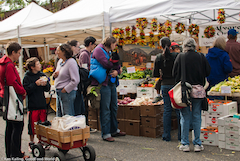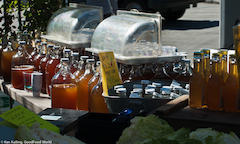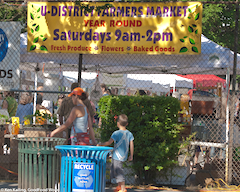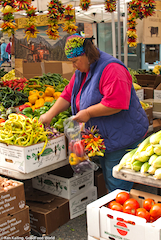Modern supermarkets are as sterile as hospitals, the produce is mostly hard as tennis balls and practically odorless and tasteless, and the staff is less than helpful when you have a question. “Aisle 7, bottom shelf…” “Sorry, we’re out of that brand…” “We can’t break down packages into single servings… against policy, you know.”

Today that same staff has very little connection to the food they put on the shelves. However they do have more or less regular hours, plenty of breaks, a regular paycheck, and a “climate controlled” working environment…
In contrast, the farmers you meet at your local farmers market are directly connected to the food they raise and the land on which it is grown. As for regular hours: it’s sunrise to sunset, and then some. Forget a regular paycheck, and the working environment is truly “climate controlled” – it’s hot in the summer, cold in the winter, wet when it rains, and dry when it doesn’t.
Many farmers markets require the vendor to also be the producer – or at least a family member – so the farmers you meet there also have to spend hours on the road bringing their products to market. Many drive long distances each way to urban markets and some, like Hayton Farms in Washington’s Skagit Valley, sell at 55 market locations every week spread the length of Puget Sound. Members of the Alvarez family, Alvarez Organic Farms south of Yakima WA, sell 300 different vegetable varieties at nearly 20 farmers markets, some as much as 5 hours’ drive from the farm.
(Take a virtual tour of some of the region’s farmers markets and an indoor public market here.)
Farmers Markets Are Key to a Local Food System
The USDA has declared this week, National Farmers Market Week, to recognize the resurgence and value of farmers markets across the US. At one time farmers markets were the conventional channels for selling fresh food in US cities. In fact, most towns were built around a central square where markets were located for farmers and artisans to bring their products for sale.
In the early 1900s, nearly 40% of Americans lived on farms and much of their food was produced at home or locally. As cities grew, more and more people left the farms, and the food had to be brought to them. Today, 80% of our population lives in urban areas and less than 2% lives on farms; therefore we have been almost completely cut off from the sources of our food.

In the face of controls by local, state and national lawmakers, which have often been encouraged and even funded by the corporate food industry, an alternative food system exemplified by the farmers market has been fighting its way back to life. Consumers, who no longer trust that their “industrial” food is safe, are reaching out to local farmers, fishermen, cheese makers, bakers, and other producers for food that is organic, transitional, or chemical-free, and minimally processed.
It is today’s farmers market – ranging from a few trucks selling produce for a few weeks during the growing season to permanent, well-established gatherings of hundreds of vendors open year ‘round – that is reconnecting American consumer to his or her food, the growers and producers, and the land. Farmers markets not only give people access to good food, they are becoming the new public square and developing into lively meeting places.
Research presented in the Journal of Environmental Psychology as described in Market Forces, a recent report published by the Union of Concerned Scientists, shows that only 9% of customers in chain supermarkets had a social interaction with another customer and 14% had a social interaction with an employee. On the other hand, at farmers markets 63% of shoppers had a social interaction with another customer, and 42% had social interactions with vendors. Those social interactions are critical to keeping consumers shopping at farmers markets.
Farmers Markets Are Big Business

In 1970 there were only 340 farmers markets; today – 41 years later – there are nearly 7,200 markets listed on the USDA directory of farmers markets. That doesn’t take into consideration informal markets that haven’t made it into the directory. More than 137,000 farmers sell $1.2 billion worth of products direct to consumers, through farmers markets, CSA (Community Supported Agriculture) subscriptions and memberships, and other direct channels.
Launched in 1972, the Dane County Farmers Market, the largest producer-only farmers‘ market in the country, draws an average of 25,000 visitors each market day. More than 150 vendors are represented every sale day and the market is so popular that there is a 5-year waiting list for vendors wanting to participate.
Local food spending at farmers markets benefits both the farmer and the community. More than a third of the small farms (under 100 acres) in Washington sell their products at farmers markets. For every $1 spent at a Washington farmers market, approximately 62% goes into the pockets of the farmers. In fact, farmers can take in up to seven times greater net revenue on a per unit basis from selling locally than selling to the conventional food distribution system.
Farmers Markets Are Educational

What better place to try something new? Farmers markets display “ordinary” fruits and vegetables along side unusual, heritage or heirloom, and new varieties, tempting us to taste and to try cooking with something different.
Try those candy-striped beets, those red spotted beans, how about those peppers that are so purple they are nearly black? Even if you could find them in the supermarket, they would most likely be limp and overpriced.
Market Forces also notes that in a survey of farmers market customers in New Orleans, 83% reported that the market had changed the way they shopped and 74% said it had introduced them to new foods.
Farmers Markets are Business Incubators
Farmers markets are great business incubators for small farmers and food processors. Farmers who sell through farmers markets generally try their hands at additional entrepreneurial activities by expanding product lines; venturing into value-added product development (manufactured, prepared and processed foods); and sharpening customer relations, merchandising, and pricing skills.
Depending on the size and sophistication of the farmers market operational structure, the market can provide marketing, infrastructure, and sales support as producers experiment with new products.
While farmers markets must maintain high levels of food safety, the 2010 Food Safety Modernization Act allows small farms that sell their products direct to consumers to be exempt from federal requirements. States are also developing product guidelines and some allow smaller food producers to use their own kitchens rather than a certified commercial kitchen.
Local – Not Global – Food System
Together we can break the energy-intensive global industrial food supply chain by seeking out – and celebrating – the farmers, ranchers, fishermen, dairymen, butchers and bakers who can put good food directly into our hands. Our local farmers markets are the best way to make those connections – and to take back our local food network.
________________________________________
Resources:
Market Forces – Creating Jobs Through Public Investment in Local and Regional Food Systems, Union of Concerned Scientists, August 2011
The Farmers Market Coalition seeks to strengthen farmers markets’ capacity to serve farmers, consumers, and communities by providing the rapidly growing movement with information and representation at state and federal levels.

One thought on “Farmers Markets – The Alternative Food System”
Comments are closed.